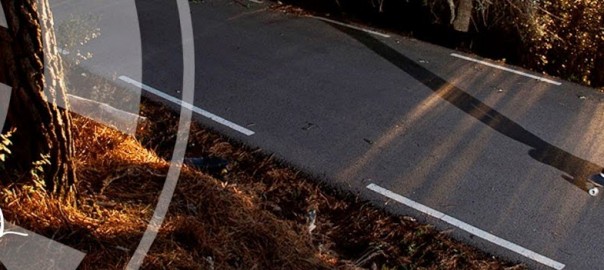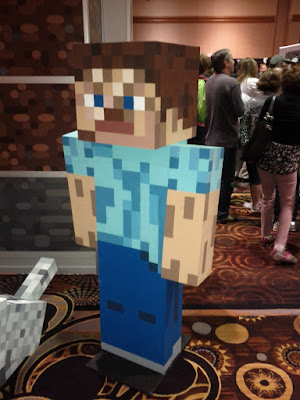In 2011 I had the opportunity to co-chair a conference with prof. Ani Nahapetian from UCLA. Now that the proceedings from The Third International Conference on Mobile Computing, Applications, and Services (MobiCASE 2011) have been published by Springer, I thought I’d share a few experiences with future generations of conference co-chairs.
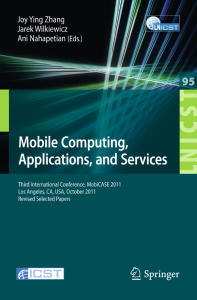
MobiCASE Conference Proceedings
If you have not heard about MobiCASE, perhaps I should start with a short overview. Not to be confused with computer aided software engineering (CASE), the conference focuses on the mobile applications, and for us, the organizers, that meant that anything below layer 5 in the OSI model was outside of the scope. The conference was held in the beautiful Santa Monica, CA, in October of 2011. The conference was sponsored by ICST and endorsed by the European Alliance for Innovation, with technical co-sponsorship from IEEE Computer Society.
I first came to know about the conference as a graduate student at Carnegie Mellon Silicon Valley, and presented a poster on YouTube Direct at the 2nd conference in 2010. In late Fall of 2010, the conference’s steering committee approached me about co-chairing the third conference, and I readily agreed, not fully appreciating the time and effort this would entail. Which brings me to my first piece of advice:
1. If you think chairing a conference is largely a ceremonial post, think again.
While the first few weeks did not require much time investment, once the organizing committee was formed, we need to have a weekly call and devote a couple of hours each and every week to make sure things stay on track. This only accelerated as we got closer to the conference. Thankfully, I was able to spend some of my 20% time at Google on MobiCASE.
Right from the start we decided to set some goals around a) international participation and b) industry presence. Since the conference takes place in the US, it was very easy to end up with primarily US papers, and the world is, you know, a big place. To that end, we’ve used Google Analytics to monitor the traction our web site was getting from countries, and in particular, universities around the world. This way we could adjust outreach appropriately. Below is an example generated using Fusion Tables form the Google Analytics site data.
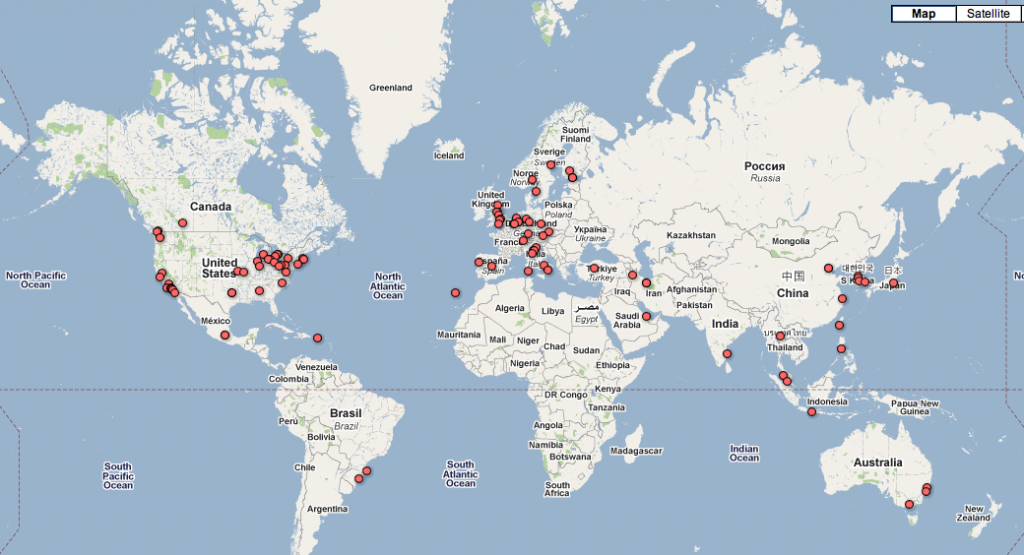
Red dots represent locations with universities which interacted with our site in the Spring of 2011. By looking at the map we realized there were a few countries where more outreach was needed. I must admit that without analytics we’d be flying blind, so if you are thinking about running a conference or any other event, remember that:
2. Site analytics is your best friend. Use it.
While organizing the conference we worked with Create-Net which helped with some of the logistics. Create-Net has its own process for running conferences with well-defined roles and responsibilities (R&Rs) listed below:
- Technical Program Chair (TPC) – drivers the review process
- Publications Chair – makes sure proceedings gets published
- Publicity Chair – drives social media, announcements (e.g. Call for Papers)
- Local Chair – makes local site arrangements
- Web Chair – takes care of the Web site
- Workshops Chair – reviews workshops submissions and runs the workshops
- Demos and Tutorials Chair – sames as above for demos and tutorials
- Panels Chair – same as above for panels
- Sponsorship and Exhibits Chair – “show me the money”
- Posters Chair – reviews poster submissions and runs the poster session
For MobiCASE we’ve mostly followed the recipe but combined some of the roles. If you are reading this because you are thinking about running your own conference, pick the ones that make most sense for you, but, by all means:
3. Define R&Rs and share it with your organizing committee early.
While we’re able to quickly identify most people responsible for all of the roles above, the Sponsorships Chair took a while. In my experience, being the Sponsorships Chair it is the toughest job at a young conference, such as MobiCASE. Most sponsors ask for the number of potential participants rather than quality of papers or any other criteria. If you conference is not yet established, finding sponsors willing to pick up the tab is quite a challenge. Somebody famous once said that “The hardest thing to do is to make a man (woman) part with his (her) money”. MobiCASE 2011 was no exception. Our sponsorships chair worked his rolodex very hard, but it was very challenging to obtain meaningful contributions to help offset the cost of the conference. Therefore, my advice is to:
4. Hire a “salesperson” as your Sponsorships Chair.
Since MobiCASE has mostly an academic character, the paper review process was very important. This is where your Technical Program Chair can make or break the conference. For MobiCASE 2011, our TPC was Prof. Joy Ying Zhang from CMU and he did an excellent job assembling an international group of reviewers (program committee), driving the process and formalizing the call for papers (CFP). In case you’re curious, here’s the MobiCASE 2011 Call for Papers.
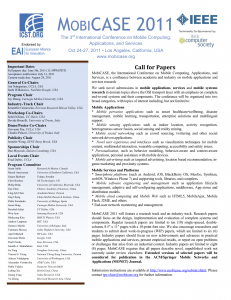
One important aspect of the review process is eliminating bias. For MobiCASE, we’ve chosen to adopt the double-blind peer review and it has served us well:
5. When in doubt, go double-blind.
One of the more mundane aspects of running a conference are site logistics. Expect to spend fair amount of time dealing with that. Therefore, it is best to find somebody who lives in the area where the conference will be held ahead of time. In other words:
6. Make sure your Local Chair is in fact…local.
That last point may sound obvious, but only a local Local Chair can properly evaluate a conference venue and consider factors such as rush-hour traffic, proximity to local attractions, quality of the facilities, and so on. Make sure to do at least two thorough walkthroughs before the day of your conference. We’re quite fortunate for MobiCASE as two members of the organizing committee lived in the LA area, so we’re able to pick a nice venue in Santa Monica that did not explode the budget.
Earlier in this post I mentioned using Google Analytics to understand the traction your conference is getting (or not). This is one of the tasks that your Publicity Chair should be confortable with. In general, you should:
7. Find a demand hacker to be your Publicity Chair.
If you’ve not heard the term “demand hacker” before, here’s a short explanation: a next gen marketer. Your Publicity Chair should be comfortable with not only using social media, but also hacking it, analyzing it, and making it drive interest in your conference. You can check how well your Publicity Chair is doing by looking at the analytics report every week.
In addition to international representation, we wanted MobiCASE to have a mixed academic and industrial focus. For MobiCASE 2011 our results were not very good in this regard. While we did get interest and paper submissions from traditional research organizations within large corporations, the bleeding edge for mobile apps is often happening at small startups doing innovative work. Unfortunately, the paper format with a strict submission and review process is not a good fit to attract their attention. The poster, workshop and panels are much more attractive opportunities to participate for them. The lesson there is:
8. Do not freak out the innovators who are too busy to write a paper.
Ok, as they say hindsight is 20/20 but here are some stats from MobiCASE 2011:
- Number of submitted papers: 50
- Number of accepted papers: 18
- Paper acceptance ratio: 36%
As far as international participation goes, we did hit the objective of making MobiCASE an international conference. With 16 countries represented at the conference in Santa Monica, you can see the participant distribution chart below.
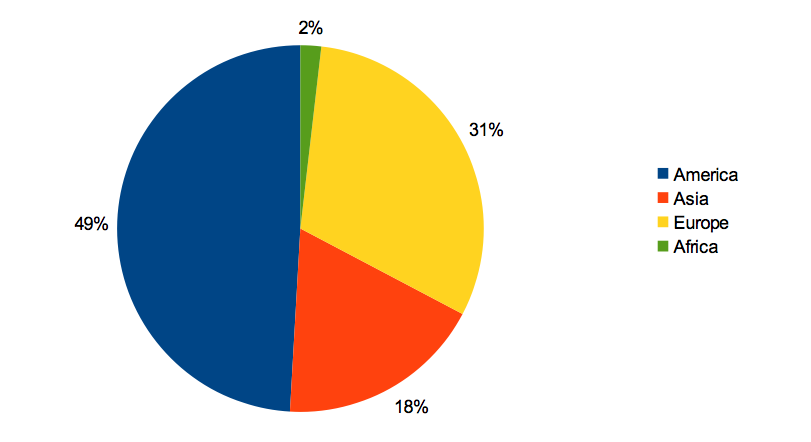
The best paper award went to the XMLVM team led by prof. Arno Puder of San Francisco State University pictured below:

Arno Puder, SFSU, photo by Thomas Phan
Hopefully you will find at least some of my ramblings useful. If you are working on on a conference yourself I wish you good luck with your endeavor. You will probably spend more time on it than anticipated, but will likely be surprised by the fun and enrichment that comes with it.

